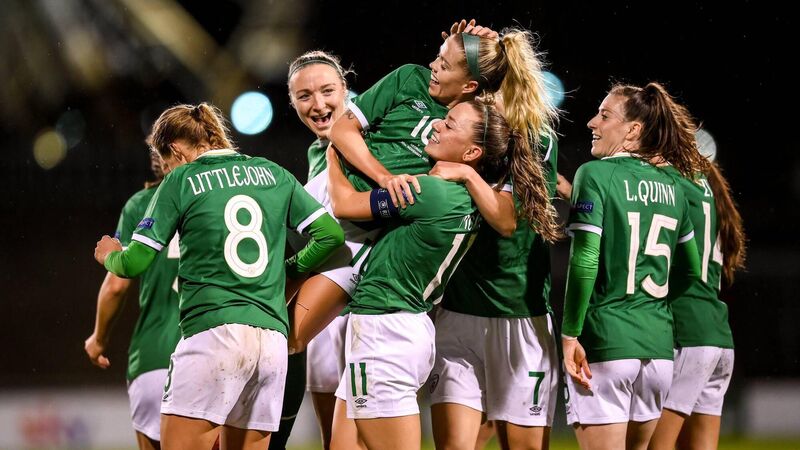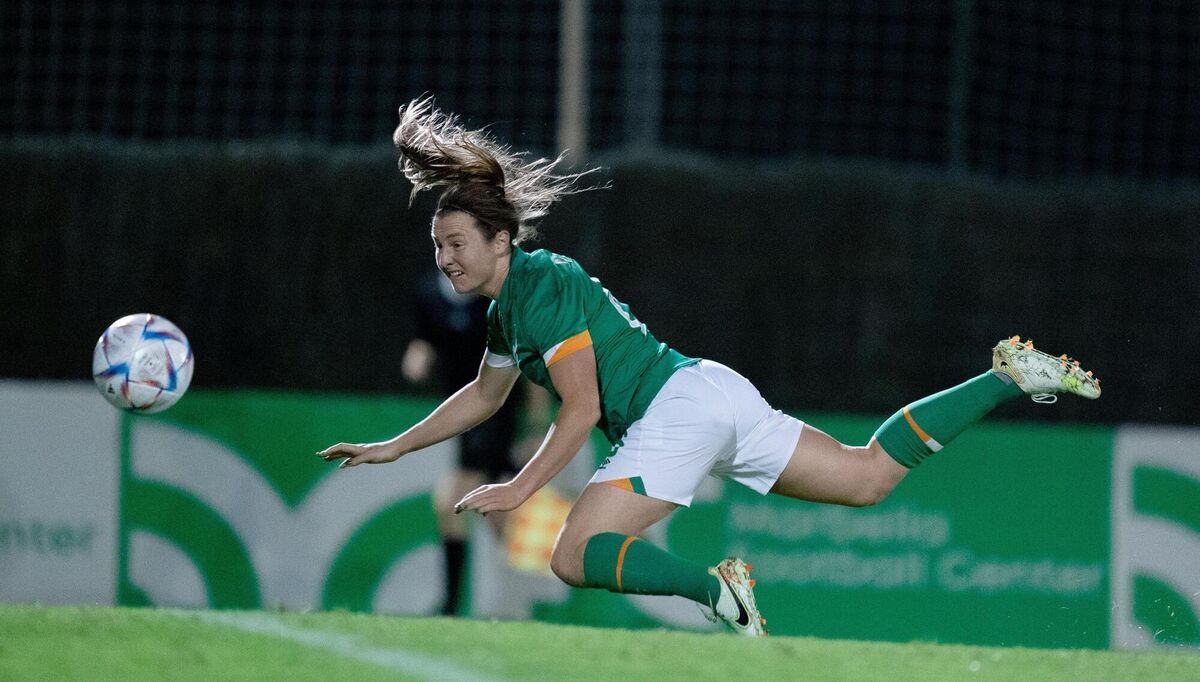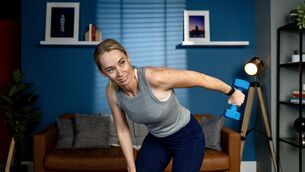Period chat and info — a move towards honesty and more support for women athletes

Denise O'Sullivan of Republic of Ireland is lifted in celebration by team-mate Katie McCabe after scoring her side's sixth goal during the FIFA Women's World Cup 2023 qualifying group A match between Republic of Ireland and Georgia at Tallaght Stadium in Dublin. Pic: Stephen McCarthy/Sportsfile
The Irish women’s team wore white shorts when playing against Australia in their first-ever appearance at the FIFA World Cup.
The FAI confirmed that after consulting with “the senior leadership group,” the ladies' team opted to wear “the traditional green jersey, white shorts and green socks as part of the new Castore home kit".
Their decision bucks a growing trend in women’s sport to reduce period anxiety by switching to darker-coloured shorts.
In this year’s Six Nations, Ireland women’s rugby union wore navy shorts instead of white shorts for the first time.
The team was taking cues from a number of other women’s football teams, including West Brom, Manchester City, Orlando Pride, and New Zealand’s women’s national team, and England’s Lionesses.
“I think it would make every woman’s life a lot easier,” Ireland striker, Amber Barrett, has said, despite the team’s decision not to change their uniform.
Fear of a visible leak deters many young girls from participating in sports, as indicated by a survey of 1,000 Irish and British women carried out for the menstrual tracking app FitrWoman.
Among the surveyed 16–24-year-olds who had stopped exercising due to period-related concerns, 54% attributed their decision to a fear of “showing” blood.
White sports shorts, however, are one of several obstacles presented by the menstrual cycle. In the 2023 National Health Watch Report conducted by Webdoctor.ie, 75% of the 907 menstruating respondents reported having had to restrict their daily activities due to other period-related issues. For 43% of women, period pain was the reason given for avoiding participation in sports.
From Olympic athletes to national football teams, the topic of menstrual health, as well as its implications for injury risk and physical performance, has garnered public attention. But this was not always the case.

Long before becoming an elite athlete, Orna Murray — a former cross-country junior champion from Tramore — was aware that menstruation, which brought with it a horde of bulky accessories and frequent trips to the bathroom, was a taboo conversation topic.
“It’s funny, I went to an all-girls school and we never spoke about it,” says Murray, the 29-year-old co-founder of Move2B, a project which aims to dismantle barriers for teenage girls in sport.
“If you had your period, you’d be throwing your pads and tampons up your sleeve and going to the bathroom,” she says. As a lanky teenager who grappled with “severe acne” and was noticeably taller than the other girls, Murray wore the wrong size sports bra and did not know how to use a tampon.
Years later, having gained a BA in applied psychology and an MSc in health psychology, Murray is imparting the how-to’s of these female rituals to a generation of girls and young women facing similar challenges.
Through Move2B’s educational programmes, she and her sister Niamh, a 30-year-old secondary school teacher and coach, have worked with a wide range of sports clubs and organisations. Among them are Athletics Ireland, Triathlon Ireland, Orienteering Ireland, Park Rangers FC, and Waterford FC.
The duo’s work is infused with passion for sport, sisterly banter, and a refreshing dose of honesty.
Murray says: “Niamh and I will do a lot of storytelling, and we talk about periods, embarrassment, leaking, and breast support. Stigma thrives in silence and it’s wonderful when we can get the girls to laugh about something that was previously causing them shame and stress.”
Significant changes have taken place since Murray’s early training days when period talk was often relegated to formal, segregated settings. A range of sports science and bioanalytics companies are now offering their athlete clients individualised programmes, which aim to tailor women’s training and nutritional plans to their menstrual cycles (MCs). In 2020, Chelsea Women became the first football club in the world to avail of such a consultancy plan with Galway-based bioanalytics company, Orreco.
Orreco has worked with elite athletes such as Olympic silver medallist, Sonia O’Sullivan — and in 2018, it partnered with the Ladies Gaelic Football Association (LGFA) to promote FitrWoman and deliver educational workshops for coaches and players.
Players can track and record their symptoms throughout the four phases of the MC by downloading the FitrWoman app, developed by Dr Georgie Bruinvels, an English research scientist at Orreco and an international cross-country runner.
Support staff and coaches can access this data via a platform called FitrCoach, which allows training plans to be aligned with the hormonal shifts associated with each phase.

In recent years, many football clubs have started to work training schedules around cycle syncing, a development which the former doctor for Dublin ladies Gaelic football team, Katie Lydon, has observed with some scepticism.
“The Irish soccer team and Chelsea football team would have very strong opinions on performance changes throughout the MC,” says Lydon. “But when you look at the research, there's very little evidence to suggest that that should be done.”
Kirsty Elliott-Sale, professor of female endocrinology and exercise physiology at Liverpool John Moores University, shares Lydon’s perspective. In a 2020 meta-analysis of more than 51 studies, Elliott-Sale and colleagues found that there was little variation in exercise performance across the four phases of the MC noting only a “trivial” decline during menstruation or the early follicular phase.
Following this major research, she told the Guardian last year, “I don’t personally think [tracking and cycle syncing] is going to change the face of women’s sport.”
“The issue is that there's not sufficient research [on how hormones influence exercise performance], it’s been of low quality, and it’s nearly always been done on men. That’s because they don’t have the fluctuations of an MC,” says Lydon. She hopes that more female-focused research will shape the development of guidelines for cycle-syncing across whole sports teams, but until then, she maintains that “changing training at different phases of the cycle” lacks evidence-based support. Instead, she advocates for a more personalised approach that involves targeting premenstrual symptoms through supplementation and diet.
For non-contraceptive users, Lydon says that during the premenstrual phase or the five-day interval leading up to blood loss, 90-95% of women experience at least one psychological symptom and one physical symptom, known as premenstrual syndrome (PMS). According to Lydon, the sudden drop in oestrogen and progesterone levels which coincides with the onset of blood loss can lead to a drop in energy levels in some women.
In Lydon’s view, PMS symptoms may be relieved by taking a non-steroidal anti-inflammatory like Nurofen, regularly supplementing with natural remedies such as turmeric, omega-three fatty acids, and magnesium, and reducing the intake of highly refined, processed foods. Counterintuitively, she says that exercise can alleviate PMS symptoms for some women, an observation which aligns with the findings of a global study conducted by FitrWoman and Strava in 2019. The study, involving more than 14,000 women, revealed that 78% of participants reported a reduction in MC symptoms following exercise.

In addition to these interventions, Lydon recommends that non-contraceptive users track their MC from the first day of blood loss. Though she likes the FitrWoman app, Jessica Piasecki, a lecturer in exercise physiology at Nottingham Trent University, and the second fastest female marathon runner in Britain, still endorses old-fashioned methods: “I'm all for a pen and paper. It's quite easy, it's quite therapeutic, just writing something down and building a picture over time.”
By maintaining a record, women can become acquainted with the broad range of MC symptoms beyond the classic “cramps, bloating and heavy legs".
With approximately 28 different symptoms documented in the medical literature, including 'brain fog', hunger, and changes in libido, Piasecki emphasises that less commonly recognised symptoms are often dismissed.
Along with supplying a reference point for sudden, unexplained shifts in mood or energy levels, menstrual tracking offers the advantage of foresight to professional athletes and amateurs.
Lydon says: “Let’s say you've got an Olympic Games starting on a certain date or a big competition, or even a county championship final. Tracking will tell you where you are going to be in your cycle so that you don't wake up unprepared on the morning of the event.”
Piasecki swears by prepping meals in advance, as well as proactively incorporating ice baths and additional recovery methods into your routine, ahead of an anticipated energy dip.
Beyond tracking the number of days of your period, it is equally important to monitor the volume of blood lost during menstruation. According to Lydon, this allows for the identification of menstrual dysfunction, including the loss of periods or amenorrhea, which can have lifelong implications for a person’s bone density.
Amenorrhea, commonly observed in endurance athletes, may be caused by a condition known as relative energy deficiency in sport (RED-S), which tends to arise when energy expended exceeds the amount of energy consumed.
“When I became an athlete and was training at a very elite level, a lot of the girls didn't have periods. And we thought that was all very normal. Looking back, we saw it as a sign that you were training hard... It was convenient,” says Murray.
Forced to stop training due to health complications caused by REDS, Murray now has an entirely different attitude towards her menses. She says: “Your period is such an amazing indicator of health.”
The debate surrounding the Irish squad's decision to stick with white shorts reflects our changing attitudes. Sparking valuable conversations about the need to accommodate women's menstrual cycle in sports, it's to be welcomed.

Celebrating 25 years of health and wellbeing










